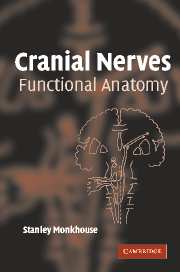Book contents
- Frontmatter
- Contents
- List of Figures
- List of Tables
- Acknowledgements
- A note to the reader
- Part I Organization of the cranial nerves
- 1 General considerations
- 2 Cranial nerve motor fibres and nuclei
- 3 Cranial nerve motor pathways: upper and lower motor neurons
- 4 Cranial nerve sensory fibres, brain stem sensory nuclei and tracts
- Part II-V Individual cranial nerves and functional considerations
- Part II Trigeminal, facial and hypoglossal nerves
- Part III Glossopharyngeal, vagus and accessory nerves
- Part IV Autonomic components of cranial nerves, taste and smell
- Part V Vision, eye movements, hearing and balance: optic, oculomotor, trochlear, abducens and vestibulocochlear nerves
- Further reading
- Index
4 - Cranial nerve sensory fibres, brain stem sensory nuclei and tracts
Published online by Cambridge University Press: 25 August 2009
- Frontmatter
- Contents
- List of Figures
- List of Tables
- Acknowledgements
- A note to the reader
- Part I Organization of the cranial nerves
- 1 General considerations
- 2 Cranial nerve motor fibres and nuclei
- 3 Cranial nerve motor pathways: upper and lower motor neurons
- 4 Cranial nerve sensory fibres, brain stem sensory nuclei and tracts
- Part II-V Individual cranial nerves and functional considerations
- Part II Trigeminal, facial and hypoglossal nerves
- Part III Glossopharyngeal, vagus and accessory nerves
- Part IV Autonomic components of cranial nerves, taste and smell
- Part V Vision, eye movements, hearing and balance: optic, oculomotor, trochlear, abducens and vestibulocochlear nerves
- Further reading
- Index
Summary
Note: Sensory fibres carried by the olfactory, optic and vestibulocochlear nerves are not dealt with in this chapter. Consult Chapters 18, 20 and 23.
The basic plan of sensory systems
The basic sensory system consists of three neuronal groups:
primary sensory neurons from receptor to central nucleus, with its cell body in a peripheral sensory ganglion;
secondary sensory neurons from nucleus to diencephalon (usually the thalamus);
tertiary sensory neurons from thalamus to cortex.
There are no synapses outside the brain and spinal cord: the first synapse is in the central nervous system (CNS) between primary and secondary sensory neurons.
Primary sensory neuron: receptor to sensory nucleus
This extends from peripheral receptor to CNS. The cell body is situated in a peripheral ganglion (dorsal root ganglion for spinal nerves) and the neuron is usually pseudounipolar, that is to say, it gives rise to a single axon which bifurcates into a peripheral process passing to the receptor, and a central process passing into the CNS. The cell body is thus both structurally and electrically out on a limb. The central process of the primary sensory neuron terminates by synapsing in a central nucleus which consists of cell bodies of the neuron next in the pathway …
Secondary sensory neurons: sensory nucleus to thalamus
The axons of these neurons ascend from the nucleus, which contains their cell bodies, to the contralateral thalamus (in the diencephalon), decussating soon after leaving the nucleus.
- Type
- Chapter
- Information
- Cranial NervesFunctional Anatomy, pp. 31 - 38Publisher: Cambridge University PressPrint publication year: 2005

